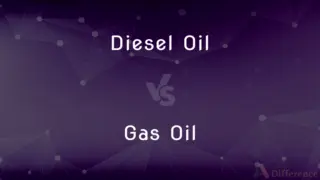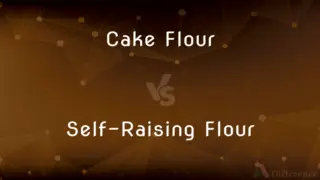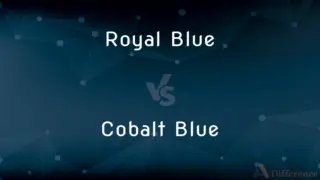Raceme vs. Corymb — What's the Difference?
By Fiza Rafique & Maham Liaqat — Updated on May 17, 2024
A raceme is a flower cluster with stalked flowers arranged along a central stem, while a corymb is a flower cluster where the outer flowers have longer stalks, creating a flat-topped appearance.

Difference Between Raceme and Corymb
Table of Contents
ADVERTISEMENT
Key Differences
A raceme is an inflorescence type characterized by a central stem with flowers borne on short, equal-length pedicels (flower stalks) along its length. A corymb, on the other hand, is an inflorescence where the individual flower stalks (pedicels) grow to different lengths, with the outer flowers having longer stalks than the inner ones.
The flowering pattern of racemes, with older flowers at the base and younger ones at the top, contrasts with the corymb's simultaneous blooming at a uniform height, which can aid in different pollination strategies.
While both racemes and corymbs are types of inflorescences used by plants to optimize reproduction, their structural differences result in distinct visual and functional characteristics that suit different environmental and ecological needs.
Comparison Chart
Structure
Central stem with evenly spaced flowers
Flowers with varying stalk lengths, creating a flat top
Flower Arrangement
Stalked flowers along a central axis
Outer flowers with longer stalks, forming a flat or convex top
ADVERTISEMENT
Blooming Sequence
Bottom flowers bloom first
All flowers bloom at the same height
Example Plants
Lupines, snapdragons
Yarrow, hawthorn
Visual Appearance
Elongated, vertical
Compact, broader, flat-topped
Compare with Definitions
Raceme
A flower cluster with older flowers at the base and younger ones towards the tip.
As the raceme grew, new flowers appeared at the top of the stalk.
Corymb
A type of flower arrangement where all flowers reach the same height despite different stalk lengths.
The corymb ensured that all flowers were equally accessible to pollinators.
Raceme
A type of inflorescence where each flower has its own stalk, attached to a main stem.
The snapdragon plant is known for its colorful raceme structure.
Corymb
A compact and broad inflorescence, often seen in shrubs and small trees.
The corymb of the spirea made the plant look full and lush.
Raceme
A simple, unbranched inflorescence with flowers on pedicels of equal length.
The raceme of the foxglove created a striking vertical display.
Corymb
An inflorescence where flower stalks grow to different lengths to form a level cluster.
The hawthorn tree's corymbs were covered in delicate white flowers.
Raceme
An elongated flower cluster with flowers on short stalks along a central stem.
The lupine displayed a beautiful raceme with flowers blooming from bottom to top.
Corymb
A flat-topped or slightly convex flower cluster with outer flowers having longer stalks.
The corymb of the yarrow plant created an even, horizontal display.
Raceme
A common floral arrangement in many herbaceous plants.
The raceme of the mustard plant attracted numerous pollinators.
Corymb
An arrangement that creates a broad, flat visual effect in a flower cluster.
The corymbs on the elderberry bush were a striking feature in the garden.
Raceme
A raceme ( or ) or racemoid is an unbranched, indeterminate type of inflorescence bearing pedicellate flowers (flowers having short floral stalks called pedicels) along its axis. In botany, an axis means a shoot, in this case one bearing the flowers.
Corymb
Corymb is a botanical term for an inflorescence with the flowers growing in such a fashion that the outermost are borne on longer pedicels than the inner, bringing all flowers up to a common level. A corymb has a flattish top with a superficial resemblance towards an umbel, and may have a branching structure similar to a panicle.
Raceme
An inflorescence having stalked flowers arranged singly along an elongated unbranched axis, with the flowers at the bottom opening first.
Corymb
A usually flat-topped flower cluster in which the individual flower stalks grow upward from various points of the main stem to approximately the same height.
Raceme
(botany) An indeterminate inflorescence in which the flowers are arranged along a single central axis.
Corymb
(botany) A cluster of flowers with a flat or convex top.
Raceme
A flower cluster with an elongated axis and many one-flowered lateral pedicels, as in the currant and chokecherry.
Corymb
A flat-topped or convex cluster of flowers, each on its own footstalk, and arising from different points of a common axis, the outermost blossoms expanding first, as in the hawthorn.
Raceme
Usually elongate cluster of flowers along the main stem in which the flowers at the base open first
Corymb
Flat-topped or convex inflorescence in which the individual flower stalks grow upward from various points on the main stem to approximately the same height; outer flowers open first
Common Curiosities
What is a raceme?
A raceme is an elongated flower cluster with flowers borne on short, equal-length stalks along a central stem.
Which plants typically have racemes?
Plants like lupines and snapdragons typically have racemes.
How do racemes and corymbs differ in structure?
Racemes have evenly spaced flowers along a central stem, while corymbs have varying stalk lengths, resulting in a flat-topped flower cluster.
How does the blooming sequence differ between racemes and corymbs?
In racemes, the bottom flowers bloom first, while in corymbs, all flowers bloom at the same height.
What visual effect does a raceme create?
Racemes create an elongated, vertical appearance.
Why might a plant have a corymb instead of a raceme?
A corymb might be more effective for attracting pollinators with its even height and compact arrangement.
What visual effect does a corymb create?
Corymbs create a compact, broader, flat-topped appearance.
What role do corymbs play in plant reproduction?
Corymbs create a uniform flower display that can be more visually attractive to pollinators, potentially enhancing pollination efficiency.
How do racemes and corymbs aid in plant identification?
The distinct structures of racemes and corymbs are key characteristics used in identifying and classifying plants.
What is a corymb?
A corymb is a flower cluster where the outer flowers have longer stalks, creating a flat-topped appearance.
Which plants typically have corymbs?
Plants like yarrow and hawthorn typically have corymbs.
What role do racemes play in plant reproduction?
Racemes help in sequential blooming, which can prolong the period during which a plant can attract pollinators.
What is a common characteristic of all racemes?
A common characteristic of all racemes is that they have a central stem with flowers on short stalks along its length.
Can a single plant species have both racemes and corymbs?
Generally, a plant species will have one type of inflorescence, but variations can occur in related species or different cultivars.
What is a common characteristic of all corymbs?
A common characteristic of all corymbs is that they have a flat-topped or slightly convex flower cluster due to varying stalk lengths.
Share Your Discovery

Previous Comparison
Handi vs. Mandi
Next Comparison
Mineral vs. CeramicAuthor Spotlight
Written by
Fiza RafiqueFiza Rafique is a skilled content writer at AskDifference.com, where she meticulously refines and enhances written pieces. Drawing from her vast editorial expertise, Fiza ensures clarity, accuracy, and precision in every article. Passionate about language, she continually seeks to elevate the quality of content for readers worldwide.
Co-written by
Maham Liaqat












































